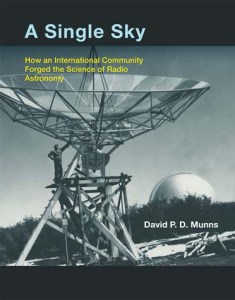 David P. D. Munns. A Single Sky: How an International Community Forged the Science of Radio Astronomy. Cambridge, MA: The MIT Press, 2013. x + 247 pp., illus., acknowledgments, list of abbreviations, notes, bibliography, index. ISBN 978-0-262-01833-3. $34.00, £23.95 (hardcover).
David P. D. Munns. A Single Sky: How an International Community Forged the Science of Radio Astronomy. Cambridge, MA: The MIT Press, 2013. x + 247 pp., illus., acknowledgments, list of abbreviations, notes, bibliography, index. ISBN 978-0-262-01833-3. $34.00, £23.95 (hardcover).
In A Single Sky: How an International Community Forged the Science of Radio Astronomy David P.D. Munns focuses on the international group of often warring scientists and engineers that created a critically important astronomical capability in the aftermath of World War II. While astronomy is centuries old—some would argue that it is the oldest scientific discipline—venturing into the non-visible part of the electromagnetic spectrum is a twentieth century phenomenon.
Radio astronomy is the application of a wartime technology to a nonviolent pursuit, even though the first such postwar application was the related technology of radar astronomy. Creating a new perspective on the universe, radio astronomy came about because of the efforts of astronomers and engineers around the world who over time established observatories to view the cosmos.
Taking something of a cultural anthropological approach, Munns offers disparate stories about Australian, British, Dutch, and American efforts to develop and use this technology. Through their efforts they created a community of scientists, aided and sometimes opposed by engineers and others. This is fundamentally a study of discipline formation, international integration, and cooperative push/pull. It is not the first work to explore discipline formation in the history of astronomy, but it is a useful investigation of an important subgroup in the field.

